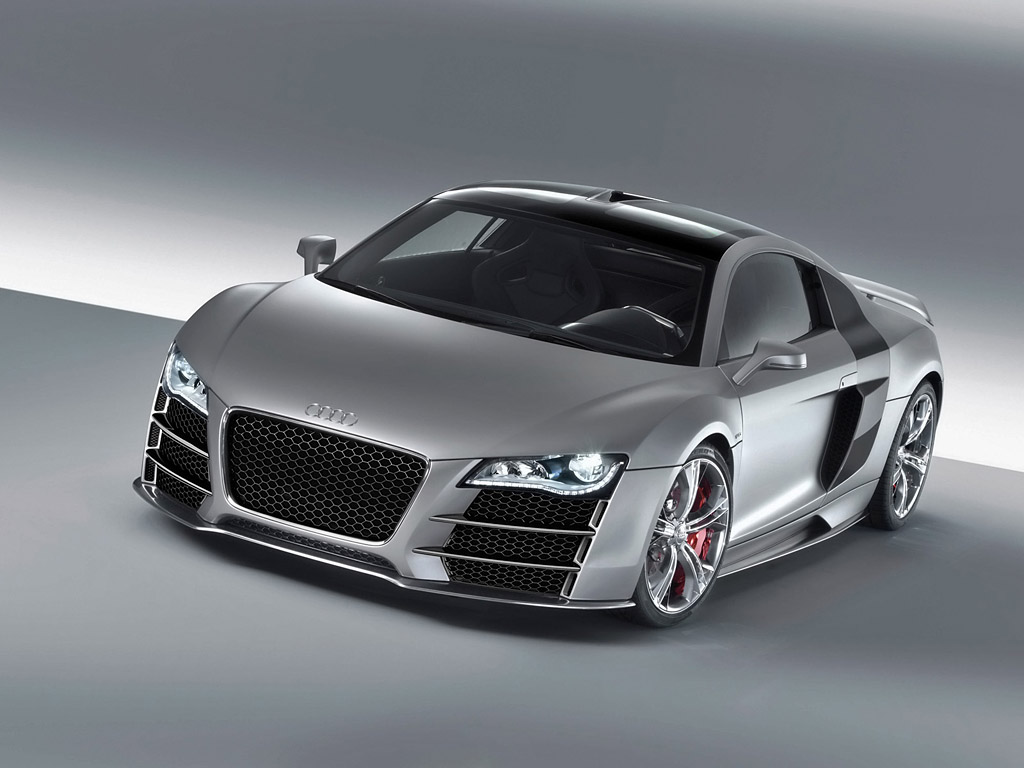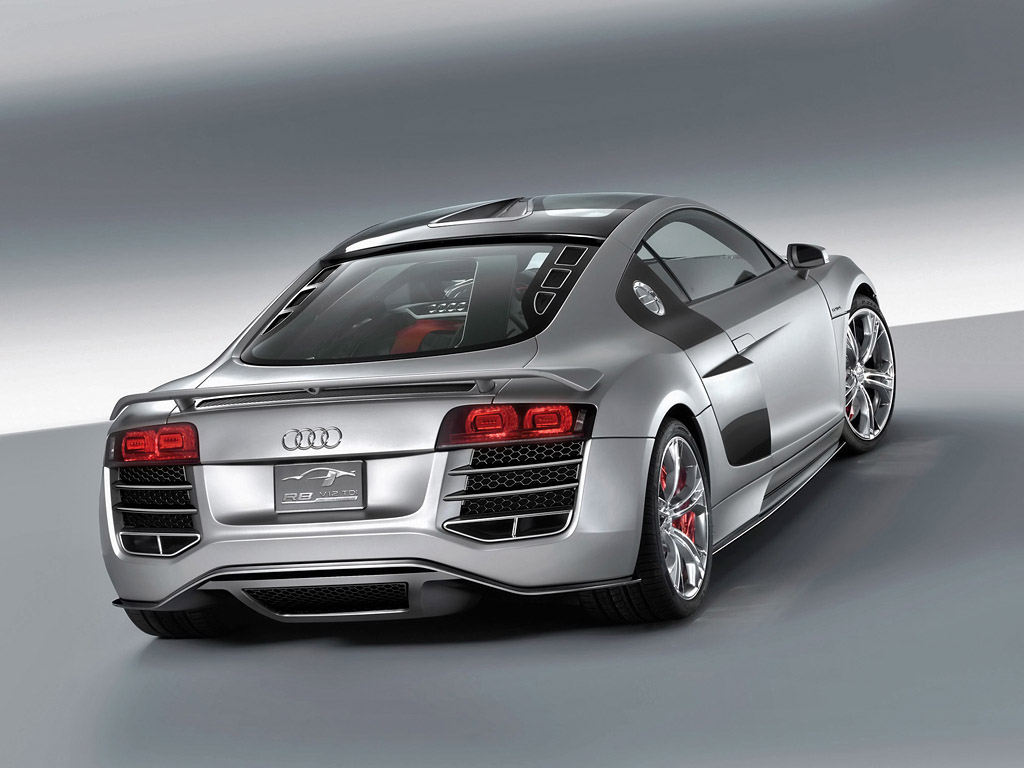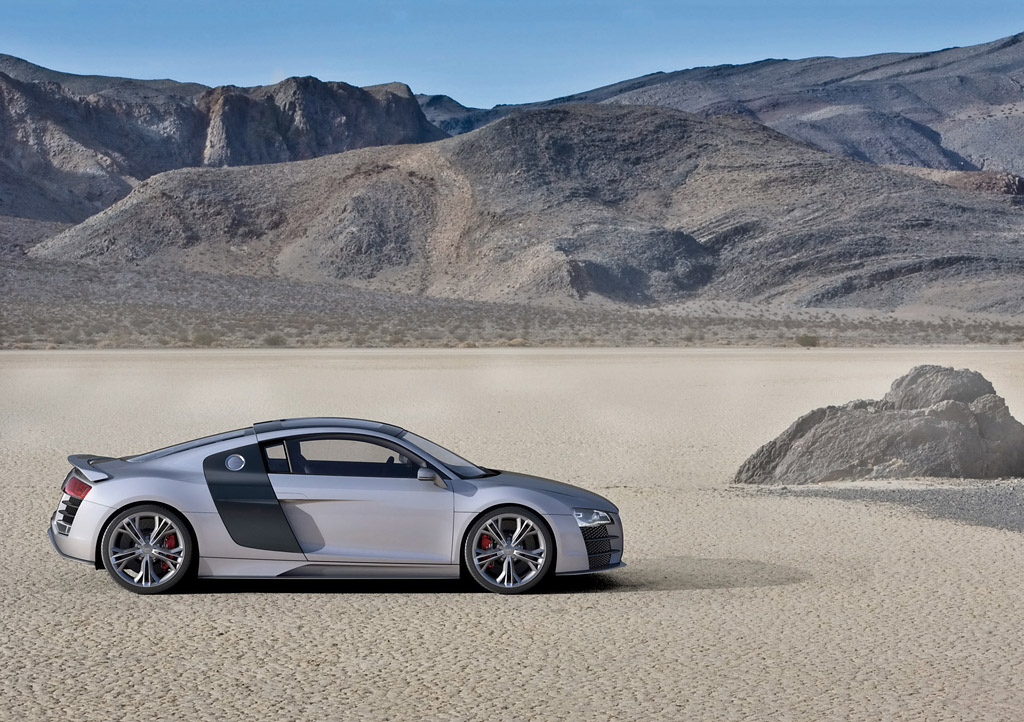2008 Audi R8 V12 TDI Concept
sections. These, together with the glazed engine compartment behind, create a radically new formal element. The unmistakable NACA duct in the middle of the roof is a functional detail that is normally reserved for racing cars. Its ingenious shape accelerates the air drawn in here for the two cylinder banks of the V12 TDI engine.
The V12 TDI is displayed as the beating heart of this sports car, like a work of art inside a large showcase. Its look, underscored by the air deflectors located beneath the restyled rear glass lid, differs clearly from its production counterpart. The engine can even be seen after dark, when white light-emitting diodes illuminate the engine compartment – as on the production R8 version. This “showroom” can additionally be fully lined in genuine carbon fiber, for a particularly exclusive look.
The continuous line running from the front apron across the wheel arches and flanks to the tail end, then back down the other side, is one of the latest design hallmarks of the Audi brand. This “loop” naturally encompasses the air apertures, the headlights and the taillights.
Unmistakable Face by Day and Night
The passion expressed through the elaborate design of the lights is another typical Audi trait. Nor is anyone likely to overlook this Audi sports car from behind: the LED taillights have a three-dimensional look that can’t be missed.
But the absolute highlight is the all-LED headlights of the study vehicle. With their lenses and reflectors, not only do these innovative light sources have a ground-breaking appearance, they also have an enormous functional advantage: LED light, with its color temperature of 6,000 Kelvin, resembles daylight much more closely than xenon or even halogen light. Better light means the driver will have much less fatigue when driving at night.
Ergonomic and Elegant
The interior’s design is as sporty and exclusive as the exterior: the characteristic element here is the monoposto – an expansive arc running around the steering wheel and instruments, connecting the driver to the car. The interior consequently picks up on the dynamism of the R8 V12 TDI concept and gives it tactile expression in a form that is accessible the moment you climb in.
The three-spoke sport steering wheel of course remains the focal point of the car’s controls. With a diameter of 365 mm (14.37 in.), it is both sportily compact and ergonomic in shape. The steering wheel rim has a flat lower edge. This is a further aspect of the auto racing feel in the Audi R8 V12 TDI, but one that also brings major functional benefits, facilitating entry and exit for the driver. The steering wheel is covered in fine Valcona leather, with a diecast magnesium core providing strength.
The start/stop button for the engine and the Drive Select switch with the Dynamic/ Sport/Race settings are arranged on the steering wheel. The latter controls the engine and transmission electronics as well as the magnetic ride dampeners in each of three different modes.
In Race mode, the instrument lighting changes from white to red. The navigation system shows a combined display with lap timer and navigation information for the racetrack being driven. Or supplementary information such as centrifugal force and boost pressure can be called up.
Concentrating on the essentials was the priority in the ergonomic arrangement of all Audi R8 versions. The most important consideration – particularly for high-speed driving – is short reach distances for all controls, to keep the time that the driver has only one hand on the steering wheel to a bare minimum. In typical Audi style the monitor is well within the field of view, and the elements of the MMI operating system are located directly below it.
Compared with the production version, the R8 V12 TDI concept’s interior has much larger aluminum applications, especially around the center console. The many carbon fiber elements give the interior a decidedly sporty feel.
The R8’s exceptional everyday practicality for a sports car is maintained in the study vehicle’s spaciousness, even though the longer engine takes up more room. The two occupants have the generous wheelbase of 2.65 meters (8.69 ft.) to thank for the interior comfort. This means the driver and passenger will always be able to find their perfect seated position, whatever their build. The view is also very good for a mid-engine vehicle. Narrow A-posts optimize the field of view to the front and sides.
The aerodynamics experts at Audi have done their work so thoroughly on the study car that, as an added benefit of its elegant shape, the body actually generates downforce – unlike many other sports cars. This aids directional stability at high speeds. It is achieved partly by means of an extending rear spoiler that is much larger than on the production version, and also thanks to the fully clad diffuser underbody.
The aerodynamics experts at Audi have done their work so thoroughly on the study car that, as an added benefit of its elegant shape, the body actually generates downforce – unlike many other sports cars. This aids directional stability at high speeds. It is achieved partly by means of an extending rear spoiler that is much larger than on the production version, and also thanks to the fully clad diffuser underbody.
Two large-format diffuser apertures in the rear bumper demonstrate just how much aerodynamics dictate the shape of the study vehicle. The tailpipes of the exhaust system are located in pairs on the right and left above the diffuser apertures. The add-on, automatically extended rear spoiler also interacts with the air as it flows around the car. The extra downforce it provides increases the efficiency of the air intake generated by the aerodynamic design of the underbody and diffusers. At low speeds, the rear spoiler returns to its initial position.
Chassis
The precision chassis of the Audi R8 V12 TDI concept remains supremely in control of the sporty performance, but is capable of assuring relaxed driving pleasure over long distances too. The sports car is spontaneous and agile at obeying steering movements, always demonstrating exceptionally good driving safety. The suspension, with double wishbones at both the front and rear, is optimized for a neutral self-steering response and maximum ease of control.
The study car, too, has the innovative dampening technology known as Audi magnetic ride. This adapts the chassis characteristic to the profile of the road and the driver’s style within milliseconds.
Ceramic Brakes with Extreme Reserves
A generously dimensioned brake system supplies the necessary braking force. It applies a total of 24 pistons to the four brake disks, combining excellent performance with minimal weight and high durability. The disks are made from carbon fiber reinforced ceramic, a material that has repeatedly proven its worth in the aviation and aerospace sectors. The basis is very hard, frictionally resistant silicon carbide, with its diamond-like crystalline structure. Embedded in it are high-strength carbon fibers that absorb the stresses occurring in the material. The intricate geometry of cooling ducts in the ventilated disks prevents extremely high temperatures. The ceramic brake disk ring is bolted by 10 spring-loaded elements to a stainless steel central element that acts as the connection with the wheel’s hub.
The ceramic brakes are identifiable at a glance by the special red, six-piston monobloc aluminum calipers and the fixed calipers at the rear. The advantages of the ceramic brakes include a further reduction in weight of around 20 kilograms (44.09 lbs.), which in this case improves the handling characteristics and comfort. The high abrasion resistance permits an operating life of up to 300,000 kilometers (186,411 miles). Their key strength, however, is their ability to withstand very high loads. Even on the racetrack, for example, the ceramic brakes always maintain their full reserve performance.
In Detail
| submitted by | Richard Owen |
| engine | V12 TDI |
| position | Mid Longitudinal |
| aspiration | Twin Turbo |
| valvetrain | DOHC |
| fuel feed | Direct Diesel Injection |
| displacement | 5934 cc / 362.1 in³ |
| bore | 83 mm / 3.27 in |
| stroke | 91.4 mm / 3.6 in |
| compression | 16.0:1 |
| power | 372.9 kw / 500 bhp |
| specific output | 84.26 bhp per litre |
| torque | 1000 nm / 737.6 ft lbs |
| body / frame | Aluminum Space Frame |
| driven wheels | 4WD |
| f brake size | mm / in |
| r brake size | mm / in |
| f suspension | Double Wishbones |
| r suspension | Double Wishbones |
| gear ratios | :1 |
| 0 – 60 mph | ~4.1 seconds |






